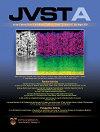晶圆键合β-Ga2O3|4H-SiC退火后的热输运和结构改善
IF 2.1
3区 材料科学
Q3 MATERIALS SCIENCE, COATINGS & FILMS
引用次数: 0
摘要
研究了键后退火对(0001)4H-SiC键合的130 nm厚脱落(201)β-Ga2O3晶圆的结构和热特性的影响。在β-Ga2O3衬底上生长了30纳米的非晶al2o3,作为β-Ga2O3和4H-SiC之间的中间层。利用表面活化键合技术进行键合,在键合界面(Al2O3|4H-SiC)处形成了一个薄的纳米非晶界面区。我们证明了在800℃下退火1 h是有益的:(1)去除脱落β-Ga2O3层中由于脱落植入引起的残余应变,(2)β-Ga2O3层中晶格嵌合性的降低,(3)非晶态键合界面区域几乎完全再结晶,(4)初始非晶态al2o3中间层部分再结晶。随着结构特性的改善,热特性也相应改善。结合β-Ga2O3层的导热系数为2.9 W/m K,结合界面的热边界导热系数为66 MW/m2 K。800℃退火1 h后,三轴x射线衍射ω:2θ测量结果表明,β-Ga2O3层应变减小,对称(201)摇摆曲线宽度减小。同时,我们观察到β-Ga2O3的导热系数增加了一倍,达到6.0 W/m K,热边界导率增加了20%。然而,进一步退火10 h后,Al2O3中间层和键合界面完全再结晶,热边界电导下降了~ 30%。这一初步结果表明,晶体异质界面不一定是热输运的最佳界面结构。本文章由计算机程序翻译,如有差异,请以英文原文为准。
Thermal transport and structural improvements due to annealing of wafer bonded β-Ga2O3|4H-SiC
The impact of postbond annealing on the structural and thermal characteristics of 130 nm thick exfoliated (201) β-Ga2O3 (via H+ ion implantation) wafer bonded to (0001) 4H-SiC was studied. Thirty nanometer amorphous-Al2O3 was grown on the β-Ga2O3 substrates prior to bonding as an interlayer between β-Ga2O3 and 4H-SiC. The surface activated bonding technique was utilized for bonding, which induces a thin nanometer amorphous interfacial region at the bonded interface (Al2O3|4H-SiC). We demonstrate annealing the bonded structure at 800 °C up to 1 h is beneficial: (1) the removal of residual strain in the exfoliated β-Ga2O3 layer that was due to the exfoliation implant, (2) reduction of lattice mosaicity in the β-Ga2O3 layer, (3) nearly complete recrystallization of the amorphous bonded interfacial region, and (4) partial recrystallization of the initially amorphous-Al2O3 interlayer. The thermal characteristics correspondingly improve with the improvement in structural characteristics. The thermal conductivity of the as-bonded β-Ga2O3 layer was 2.9 W/m K, and the thermal boundary conductance of the bonded interface was 66 MW/m2 K. After annealing at 800 °C for 1 h, triple-axis x-ray diffraction ω:2θ measurements showed a reduction in strain for the β-Ga2O3 layer and the symmetric (201) rocking curve widths. We simultaneously observe a doubling of the β-Ga2O3 thermal conductivity to 6.0 W/m K and a 20% increase in the thermal boundary conductance. However, upon further annealing up to 10 h and fully recrystallizing both the Al2O3 interlayer and bonded interface, the thermal boundary conductance dropped by ∼30%. This preliminary result suggests that crystalline heterointerfaces may not necessarily be the most optimal interfacial structure for thermal transport.
求助全文
通过发布文献求助,成功后即可免费获取论文全文。
去求助
来源期刊

Journal of Vacuum Science & Technology A
工程技术-材料科学:膜
CiteScore
5.10
自引率
10.30%
发文量
247
审稿时长
2.1 months
期刊介绍:
Journal of Vacuum Science & Technology A publishes reports of original research, letters, and review articles that focus on fundamental scientific understanding of interfaces, surfaces, plasmas and thin films and on using this understanding to advance the state-of-the-art in various technological applications.
 求助内容:
求助内容: 应助结果提醒方式:
应助结果提醒方式:


